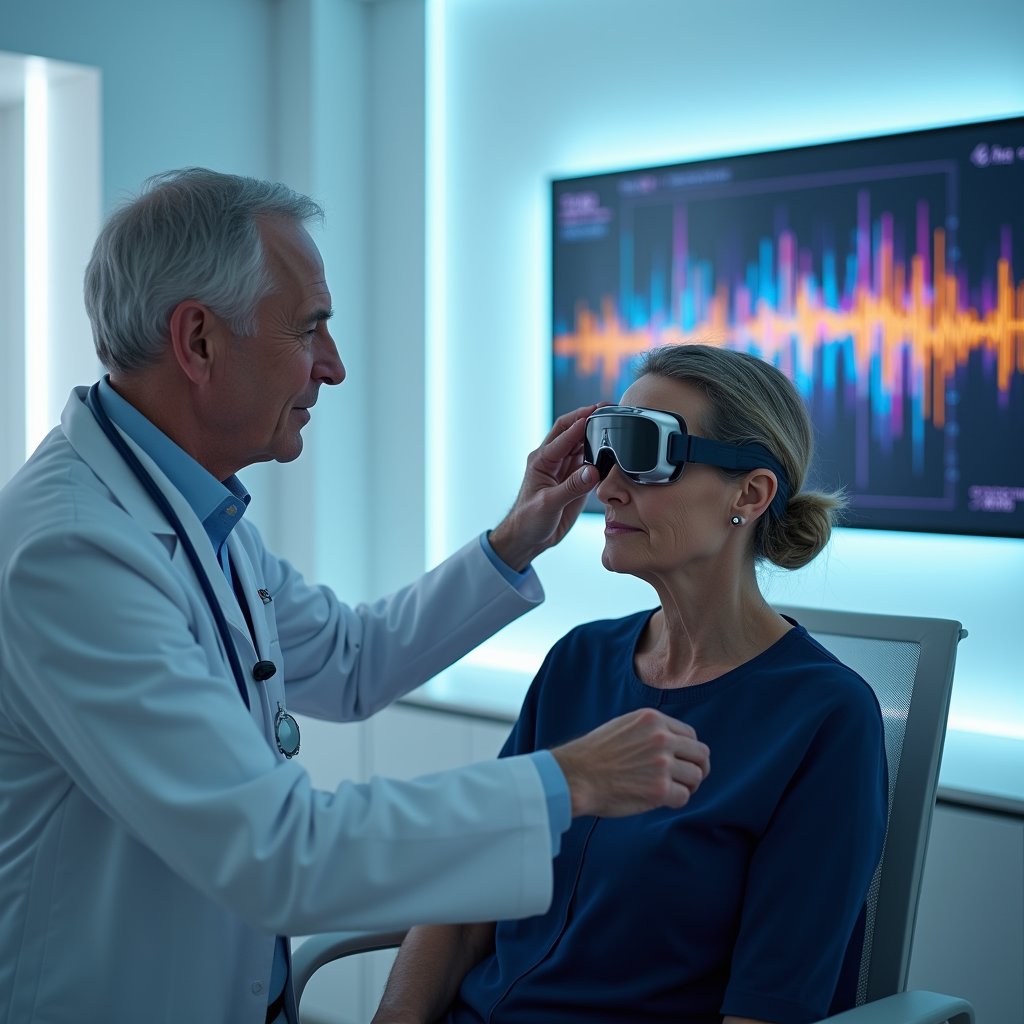Recent advances in Parkinson’s treatment have transformed patient outcomes through adaptive deep brain stimulation and personalized stem cell therapies. You’ll find FDA-approved smart algorithms now deliver precise electrical pulses based on real-time brain monitoring, while blood-derived stem cells can be reprogrammed into dopaminergic neurons for transplantation. Your genetic profile enables customized interventions, from optimized medication dosages to targeted gene therapies. These breakthroughs represent just the beginning of revolutionary treatment possibilities in 2025.
Breakthroughs in Adaptive Deep Brain Stimulation Technology

While traditional deep brain stimulation has been a cornerstone treatment for Parkinson’s disease, adaptive DBS technology has revolutionized the field with FDA-approved algorithms that dynamically respond to neural activity.
Adaptive DBS technology marks a new era in Parkinson’s treatment, offering smart algorithms that adjust stimulation based on real-time brain signals.
While traditional deep brain stimulation has been a cornerstone treatment for Parkinson’s disease, adaptive DBS technology has revolutionized the field with FDA-approved algorithms that dynamically respond to neural activity.
You’ll find that adaptive deep brain stimulation delivers precisely calibrated electrical pulses based on continuous brain monitoring, preemptively addressing symptoms before they manifest. Clinical trials demonstrate that this technology offers superior symptom management compared to conventional approaches. UCSF’s advanced algorithms, which monitor cerebral cortex signals, have achieved amplified outcomes with fewer side effects.
The system’s versatility allows customization for both motor and non-motor symptoms, adapting to your specific Parkinson’s manifestations. This breakthrough has catalyzed research into applying personalized deep brain stimulation for other neurological conditions, including depression, chronic pain, and OCD.
Emerging Stem Cell Therapies and Clinical Trial Results

Groundbreaking stem cell therapy trials at Mass General Brigham are demonstrating promising potential for Parkinson’s treatment through autologous cell transplantation. The Phase 1 clinical trial utilizes your own blood-derived stem cells, converting them into specialized dopamine-producing neurons through iPSC technology.
Key aspects of this innovative trial include:
- Conversion of patient blood cells into induced pluripotent stem cells
- Reprogramming of iPSCs into midbrain dopaminergic neurons
- Autologous transplantation to restore brain dopamine function
- NIH-NINDS funding support for expanded Phase 2A studies
The trial’s initial phase has successfully treated three patients, marking a significant advancement in cell-based therapies for neurodegenerative conditions. This pioneering approach by McLean Hospital’s researchers represents an essential step in the direction of developing personalized regenerative treatments for Parkinson’s disease using your own cells.
Real-Time Symptom Management Through Smart Algorithms

Beyond cellular therapies, advances in adaptive deep brain stimulation (aDBS) technology now offer real-time symptom management through sophisticated algorithms. You’ll find these smart devices continuously monitor your brain activity and deliver precisely calibrated electrical pulses to control Parkinson’s symptoms as they emerge.
The system’s dual-algorithm approach lets you benefit from either rapid symptom suppression or preventive maintenance of brain activity. Clinical data confirms that aDBS greatly outperforms traditional continuous stimulation, with fewer side effects and better motor function outcomes. UCSF’s improved algorithms now incorporate cortical brain signal monitoring for even more precise control. The FDA’s approval of these smart systems has expanded research into personalized deep brain stimulation for other neurological conditions, including depression and obsessive-compulsive disorder.
Personalized Treatment Approaches Based on Genetic Profiles
Through advanced genetic testing capabilities, clinicians can now map your unique genomic profile to develop precisely targeted treatment strategies for Parkinson’s disease. New pharmacogenomic analyses enable optimization of medication dosages based on your specific genetic markers, maximizing therapeutic benefits while minimizing adverse effects.
Genetic testing advances now allow doctors to create personalized treatment plans for Parkinson’s disease, optimizing medication based on individual DNA markers.
- Your genetic profile reveals disease-specific biomarkers, allowing clinicians to predict progression patterns and implement proactive interventions
- Advanced gene therapy techniques target identified genetic defects, potentially halting neurodegeneration at its molecular source
- Customized combination therapies address multiple pathological pathways based on your individual genomic terrain
- Continuous monitoring of genetic expression patterns enables real-time adjustments to your treatment protocol
This personalized genetic approach represents a significant advancement in Parkinson’s treatment, offering targeted interventions that align precisely with your body’s molecular characteristics.
Advanced Neuroprotective Strategies and Interventions
Advances in neuroprotective strategies for Parkinson’s disease now enable you to access targeted therapies that shield brain cells through multiple mechanisms, including antioxidant pathways and inflammatory response modulation. You’ll find that novel pharmaceutical compounds specifically amplify mitochondrial function while simultaneously reducing cellular stress and protein aggregation in neurons. Research shows you can benefit from combination approaches that integrate these protective mechanisms with personalized treatment protocols, maximizing the preservation of dopaminergic neurons and slowing disease progression.
Targeting Brain Cell Protection
Modern neuroprotective strategies for Parkinson’s disease have evolved into a multi-faceted approach targeting key cellular mechanisms. You’ll find researchers developing pivotal therapies that focus on protecting and regenerating brain cells through multiple pathways.
- LRRK2 inhibitors are showing promise in preventing protein accumulation and toxicity, directly protecting vulnerable neurons from degeneration
- Advanced cell therapy techniques using induced pluripotent stem cells offer potential for replacing damaged brain cells and restoring neural function
- GDNF gene therapy delivers vital growth factors directly to affected brain regions, promoting dopaminergic neuron survival
- Immunotherapy approaches target misfolded α-synuclein proteins, helping clear toxic accumulations that damage brain cells
These targeted interventions represent significant advances in neuroprotective strategies, aiming to slow or halt disease progression while preserving essential neural functions.
Anti-Inflammatory Drug Advances
While traditional treatments have focused on symptom management, groundbreaking anti-inflammatory medications are emerging as powerful neuroprotective agents in Parkinson’s disease treatment. You’ll find significant breakthroughs in NSAIDs, with ibuprofen demonstrating remarkable ability to slow motor symptom progression in early-stage patients during the STEADY-PD III trial.
Combination therapies are showing promise, particularly prednisone when paired with dopamine agonists, yielding improved motor function and reduced neurodegeneration. The selective microglial inhibitor masitinib has completed Phase 3 trials, effectively slowing both motor and non-motor symptom progression. You’ll also see emerging therapies targeting the kynurenine pathway, offering new hope for neuroprotection. These anti-inflammatory approaches represent a paradigm shift from conventional treatments, addressing the underlying neuroinflammatory processes rather than just managing symptoms.
Mitochondrial Function Enhancement
Research into mitochondrial function optimization has revolutionized neuroprotective strategies for Parkinson’s disease treatment. The targeted approach to addressing mitochondrial dysfunction now encompasses multiple therapeutic interventions that you’ll find at the forefront of clinical applications.
Key mitochondrial-targeting interventions include:
- Small-molecule PGC-1α activators that increase mitochondrial biogenesis and protect dopaminergic neurons
- Gene therapy vectors delivering PINK1 and Parkin proteins to restore mitochondrial homeostasis
- Targeted dietary supplements including CoQ10 and NAD+ precursors that amplify cellular energy production
- Combination therapies that simultaneously address multiple pathogenic mechanisms
These advanced interventions represent a significant shift in treatment paradigms, offering neuroprotective benefits through enhanced mitochondrial function. Clinical trials continue to evaluate these approaches, with promising results suggesting improved outcomes for patients with Parkinson’s disease.
Revolutionary Drug Delivery Systems for Dopamine Regulation
The terrain of Parkinson’s disease treatment has been transformed by breakthrough drug delivery systems that optimize dopamine regulation. You’ll find advanced technologies that provide precise control over medication levels, including transdermal drug patches that sustain steady absorption while minimizing gastrointestinal complications. Inhalable dry powder formulations offer rapid relief during off-periods, while biodegradable microneedle arrays deliver long-lasting dopamine regulation with minimal invasiveness.
| Delivery System | Key Benefit | Administration |
|---|---|---|
| Implantable Pumps | Continuous delivery | Surgical implant |
| Ultrasound-mediated | Augmented BBB crossing | Non-invasive |
| Transdermal Patches | Constant absorption | Skin application |
These revolutionary delivery methods represent a significant advancement in maintaining consistent dopamine levels, reducing motor fluctuations, and improving your quality of life through targeted therapeutic approaches.
Integration of Artificial Intelligence in Treatment Monitoring
Building upon advances in drug delivery systems, artificial intelligence now revolutionizes how clinicians monitor and adjust Parkinson’s treatments. AI-powered solutions continuously analyze brain activity and cellular responses to maximize your health outcomes through personalized interventions.
- Real-time monitoring systems track your brain’s electrical patterns, automatically adjusting deep brain stimulation parameters to maintain ideal neural function
- Smart wearable sensors detect subtle motor symptom changes, precisely modifying medication dosages throughout your daily activities
- Machine learning algorithms analyze vast patient datasets to predict disease progression in your brain cells, enabling proactive treatment adjustments
- AI-powered virtual assistants engage in natural conversations to gather detailed symptom reports, providing clinicians with thorough health insights
This integration of artificial intelligence transforms Parkinson’s care into a dynamic, data-driven approach that continuously adapts to your unique treatment needs.
Novel Immunotherapy Approaches for Disease Modification
Groundbreaking immunotherapy approaches now offer disease-modifying potential for Parkinson’s disease through targeted interventions against α-synuclein proteins. You’ll find that monoclonal antibodies are leading the charge, demonstrating remarkable ability to clear pathogenic proteins and decelerate disease progression in early clinical trials.
Passive immunization strategies using anti-α-synuclein antibodies have shown significant promise in reducing Lewy body burdens and improving both motor function and cognitive outcomes. Active immunization through α-synuclein vaccines is advancing from successful preclinical studies to clinical evaluation, offering another viable therapeutic avenue.
You’ll see these immunotherapies increasingly combined with other neuroprotective treatments, creating extensive management strategies. This multi-targeted approach represents a paradigm shift in Parkinson’s treatment, moving beyond symptom management to address the fundamental causes of neurodegeneration.
Collaborative Research Initiatives and Treatment Centers
The strategic partnership between UC Irvine’s Alpha Stem Cell Clinic and leading Parkinson’s specialists across North America has established a pioneering clinical trial hub for bemdaneprocel, the initial allogeneic pluripotent stem cell therapy advancing to Phase 3 trials. You’ll find transformative research collaborations between McLean Hospital’s Neuroregeneration Research Institute and Mass General Brigham yielding groundbreaking autologous stem cell transplant trials. The NINDS CREATE Bio funding stream, combined with UCI Health’s academic network integration, is accelerating the translation of stem cell innovations into accessible clinical applications for Parkinson’s patients.
Leading Research Network Partnerships
Major advances in Parkinson’s disease treatment have emerged through strategic research partnerships, as exemplified by the collaboration between McLean Hospital’s Neuroregeneration Research Institute and Brigham and Women’s Hospital. This NIH-funded initiative demonstrates the power of institutional collaboration in advancing stem cell therapies.
- The CREATE Bio grant from NINDS has accelerated the development of autologous stem cell treatments, paralleling work at Memorial Sloan Kettering Cancer Center where Dr. Viviane Tabar pioneered human embryonic stem cell research
- Mass General Brigham’s Phase 1 trial validates the safety of patient-derived induced pluripotent stem cells
- The novel approach eliminates the need for immunosuppression by using the patient’s own cells
- Dr. Ole Isacson’s team has successfully treated three patients, setting the stage for expanded Phase 2A trials
The collaborative framework establishes a model for future translational research in neurodegenerative disorders.
Clinical Trial Hub Expansion
Since 2024, coordinated expansion of specialized clinical trial hubs has revolutionized access to experimental Parkinson’s disease treatments across the United States. You’ll find major academic centers, including Memorial Sloan, partnering with biotech innovators like BlueRock Therapeutics to accelerate phase 1 trial enrollment and data collection.
The NIH’s $100 million investment has established an interconnected network of research facilities, enabling you to participate in cutting-edge trials through the Michael J. Fox Foundation’s treatment centers. These hubs utilize standardized data sharing platforms to streamline patient recruitment and trial coordination. The FDA’s expedited review pathways guarantee promising therapies move efficiently from laboratory to clinic. This integrated approach has created unprecedented opportunities for you to access novel treatments while contributing to the advancement of Parkinson’s research.
Patient Success Stories and Quality of Life Improvements
Recent advances in Parkinson’s disease treatments have yielded remarkable patient success stories, demonstrating tangible quality of life improvements across multiple therapeutic approaches. Clinical data reveals how people with Parkinson’s have experienced significant transformations through different interventions.
- A former professional skateboarder resumed his athletic pursuits after receiving adaptive deep brain stimulation, showcasing the potential of targeted neuromodulation.
- Patients undergoing stem cell therapy trials demonstrated improved symptoms with a 20-point reduction in disease rating scales.
- Individuals using novel neuroprotective treatments, particularly antioxidant therapies, reported augmented daily functioning and slower non-motor symptom progression.
- Those treated with GLP-1 agonist exenatide and newer dopamine agonists maintained independence longer, while experiencing fewer adverse effects and better motor control.
These outcomes underscore the evolving setting of Parkinson’s treatment options and their real-world impact.
Frequently Asked Questions
What Is the Promising New Treatment for Parkinson’s Disease?
You’ll find that stem cell transplants are emerging as a groundbreaking treatment for Parkinson’s disease, complementing existing approaches like deep brain stimulation and gene therapy. This pioneering/novel/cutting-edge procedure uses your own blood cells, reprogrammed into dopaminergic neurons, which are then transplanted into your brain. The therapy’s uniqueness lies in using your own cells, eliminating the need for immunosuppression while potentially restoring normal dopamine function in affected brain regions.
What Is the New Operation for Parkinson’s?
You’ll find that adaptive deep brain stimulation (aDBS) is the latest surgical advancement for Parkinson’s treatment. Unlike traditional DBS, this smart system monitors your brain activity in real-time and automatically adjusts stimulation. While gene therapy and stem cell transplants are also emerging surgical options, aDBS stands out because it’s FDA-approved and provides personalized treatment by responding to your unique brain signals and symptoms with precision-targeted electrical pulses.
What Is the Miracle Drug for Parkinson’s Disease?
There isn’t a single miracle drug for Parkinson’s disease yet, but you’ll find multiple promising treatments emerging. You can investigate neural stem cell therapy, which targets cell regeneration, or try non-invasive brain stimulation techniques that help manage symptoms. The ketogenic diet benefits may also support your brain health. While researchers continue developing potential breakthrough treatments, you’ll need to work with your healthcare provider to determine the most effective combination of existing therapies for your specific case.
When Will Tavapadon Be Available?
Based on the current tavapadon development timeline, you can expect this drug to be available in 2025. The tavapadon clinical trials, specifically the Phase 3 TEMPO-1 and TEMPO-2 studies, are currently underway to evaluate its safety and efficacy. The tavapadon approval process includes Cerevel Therapeutics’ planned New Drug Application submission to the FDA in 2024. If approved, you’ll have access to this novel D1/D5 receptor agonist for Parkinson’s treatment in 2025.





